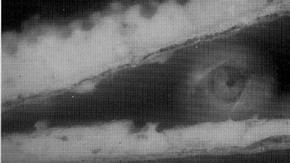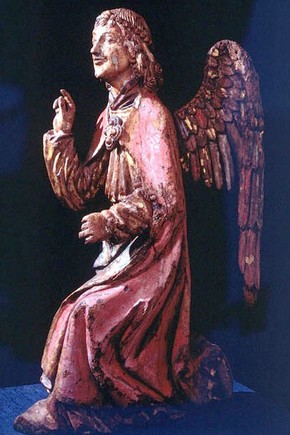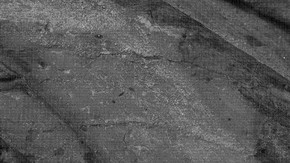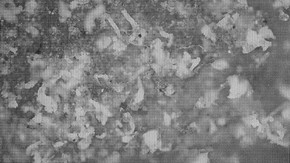Conservation Journal
July 1994 Issue 12
The angel of annunciation
The figure of the Angel, Museum No. A10-1914 (Fig 1.), which has been dated by the curatorial staff approximately in the first half of the 15th century would have been a part of an Annunciation group. Its provenance is probably Northern France. 1 It is 940 mm in height, carved in oak and polychromed but the existing polychromy is not original. The Angel kneels on its right knee, its right hand raised in the gesture of blessing. The left hand would have held a lily or a scroll, now missing. The style of the carving and the application of the polychromy suggest that the sculpture was originally intended to be viewed mostly from the front and the 'proper' (the object's) left. The figure has retained only one of its wings.
History of the conservation treatment
The figure of the Angel had been the subject of attention of the Sculpture Conservation Section since 1982, when gradual disintegration of the polychrome layer had been observed and recording of its progress begun. Numerous slides were taken at that time, some under magnification, of the powdering red paint. Although there was no written record of the previous conservation, other senior staff members (R. Cook and K. Hempel) [formerly Head of Sculpture Conservation], have recalled a change in the appearance of the object. Following further discussions a possible date of the previous conservation treatment could be placed roughly between 1950 and 1955. At that time a commonly used consolidant was Bedacryl, a butyl methacrylate, usually applied in a solution in toluene. This was usually followed by an application of paraffin wax to impart a glossy finish. 2 Bedacryl continued to be used until the early 1970s. 3
In 1982 Richard Cook initiated an analysis of the powdering layer of red polychromy on the cloak of the Angel, and of the wax-like substance found on the whole surface of the sculpture. Two samples were taken: one of the white powders on the red paint surface from a lower front fold of the drapery, and one of the waxy substance from behind the left arm of the figure. 4 The samples were analysed by the means of infrared spectroscopy. The whitish powder taken from the surface of the sculpture was compared with an ICI-produced butyl methacrylate. Although the analysis did not prove entirely conclusive, there was a significant similarity between the spectra of the two materials. There is no record of the analysis of the waxy substance.
Richard Cook further monitored the sculpture in 1991 using a video microscope. There is photographic documentation from this date, which shows disintegrating red paint intermixed with white powder falling off the object onto the floor of the case.
Sculpture Collection decided to take the Angel off display in June 1993 in order to carry out a full consolidation of the red paint of the drapery. After the initial examination it became apparent that a more thorough conservation treatment would be necessary, including cross-sectional and pigment analysis, and cleaning.
Condition before conservation
The white powdering layer (Fig. 2) of consolidant which covered the red paint of the drapery, and in some areas completely obscured its colour, was thoroughly examined under the microscope and compared with the photographic records of 10 years ago. The photographs confirmed the gradual worsening condition of the polychromy.
The microscopic examination revealed that the breaking down of the consolidant had actually affected the pigment layer underneath. Much of the painted surface was lifting and the resulting damage, found mainly on the red mantle, looked like a mixture of white ribbon-like deposit and red powder. The surface was further coated with wax which was applied very thickly, especially in the recesses of the gilded drapery on the chest and around the clasp. There is evidence of the consolidant present between various layers of the polychromy in the cross-sections. 3 (Fig. 3)

Fig 3. Cross-section of the red mantle, showing original and overpaint, with consolidant present between the layers (click image for larger version)
The timber of the figure has suffered moisture and woodworm damage during its history. The proper right wing is missing. It has been cut off and there is still a short stump remaining in wing slot, secured with a nail. The left wing is held in its place by an oak peg not contemporary with the rest of sculpture. The right foot and a part of the drapery around it is carved in separate piece of oak, joined to the main piece with two horizontally positioned oakwood dowels. Joining on of pieces of timber in figurative carving was a common technique where the composition of the sculpture exceeded the size of the available material. The finger-tips on both hands are missing, and there are losses to the edges of the draperies. The nose is a replacement. Damage to the face and the join around the replacement nose have been filled in the past with a hard filler.
Conservation treatment
Before moving the Angel to the studio the powdering red paint was consolidated with 2% methyl cellulose in water. The water-repellent surface of the paint had to be pre-wetted with ethanol. This temporary consolidation facilitated a safe handling and moving of the sculpture. It did not, however, solve the problem of securing the paint layer and enabling the removal of the problematic old consolidant and the wax layer.
After carrying out a series of tests the following treatment was decided upon:
1 Consolidation of the red paint using a heated spatula,without actually applying any adhesive. Enough thermoplastic 'consolidant' was present to hold the pigment layers in place while removing the excess materials from the surface. Consolidation of the remaining paint similarly did not require more than relaying with a heated spatula.
2 Removal of the disintegrated consolidant using cellosolve and toluene. Cellosolve was brushed on a small area of approximately 30x30 mm and left for 2-3 minutes to soften the wax and the consolidant, which were then removed with toluene on a swab. Occasionally some relaying of the paint with a heated spatula was necessary during this procedure.
3 The rest of the surface where the old consolidant had not caused any serious damage, i.e. the green and the gilded drapery, the head, the hands and the wing, were cleaned with toluene followed by white spirit. Toluene was applied to soften the wax layer, which was then mostly scraped off with small wooden and bamboo tools, after which the remaining softened wax was wiped off with white spirit. The same technique was used on the bare wood surfaces, including the areas of woodworm damage. It became obvious that not all of the wax/consolidant could be removed from both the polychromy and the bare wood. In several areas of the red drapery the consolidant layer had become irreversible and had to be left on the surface.
4 When as much of the wax/consolidant as possible was removed the question of the visual reintegration arose. After a discussion with the Sculpture Curator it was agreed that only the red paint, which had suffered disfiguring losses in the past, should be retouched. Watercolours were used to retouch the paint losses where the gesso was intact. Where all the layers of the polychromy, including the ground, had been lost no retouching was carried out.
5 Owing to the fact that the whole surface of the sculpture had been saturated in the past with various consolidants, and because of its being displayed in a case, it was decided to apply no protective layer over the cleaned and retouched surface.
Microscopic analysis 3
As the present paint on the Angel is not original, an analysis was undertaken to determine the underlying finishes, and to identify the pigments. Twelve paint samples were taken and analysed under polarised light and full incident illumination. Two paint schemes were found, both prepared with a chalk ground.
The original scheme of the early 15th century was that of a red mantle with a blue lining and gold border. The blue of the mantle lining had been executed using a grey underpaint, containing carbon black and chalk, below a layer of azurite. The wings were painted green and gold, with blue details.
The pigments identified were:
Gold leaf (over oil size containing red lead, lead white and yellow and brown ochres)
Copper resinate
Lead tin yellow
Charcoal
Chalk
Lead white
Red lead
Yellow and brown ochres
The overpaint shows the Angel in a red mantle with a green lining and gold border. The wing is multicoloured in blue, red, gold and green. The pigments present indicate a 17th-18th century paint:
Gold leaf (over oil size containing yellow and brown ochres)
Vermilion
Smalt
Copper green, possibly verditer
Lead white
Chalk
Yellow and brown ochres
The old consolidant has been found in most samples and where disintegrated appears in the form of 'ribbons' or 'teeth' which have penetrated through the upper paint surface (Fig. 4).
Future considerations
There are further questions arising about how Bedacryl was used in the past. 3 The plan now is to locate a source of Bedacryl and to carry out a comparative analysis by FTIR (Fourrier Transform Infrared Spectrometry), to definitively identify the consolidant present on the Angel. As no environmental reason for the failure of the 1950s consolidation has been found it can be assumed that the disintegration of the consolidant remaining on the surface of the object may continue. The Angel should therefore be observed and monitored on a regular basis.
References
1. Williamson, P. 'Northern Gothic Sculpture 1200-1450', V&A Museum Catalogue 1988, pp.182-186.
2. Cook, R., V&A Conservation report, 1982.
3. Darrah, J., V&A Conservation Science Group Report, 1994.
4. Martin, G., V&A Conservation Science Group Report No 107/82.
Suppliers
Cellosolve, toluene, white spirit:
Merck-BDH Ltd.
Hunter Boulevard Magna Park
Lutterworth Leics LE174XN
Methyl cellulose:
Merck-BDH Ltd.
Watercolours:
Winsor and Newton Ltd.
51 Rathbone Place
London W1P 1AB


